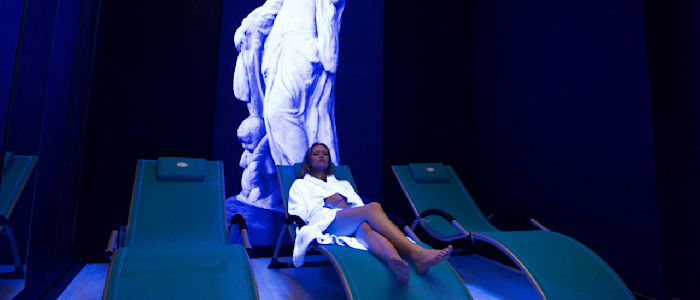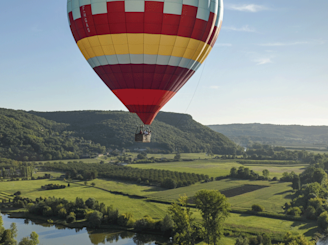You'll be plunged into the atmosphere almost before you're through the doorway of the first treatment room. Scents of peppery cinnamon and red fruits mingle with a rainbow of light that changes gradually from pink to blue, to purple then golden yellow. All this to the sound of a stream of water running in the background. Tranquillity guaranteed.
Further on, a salt cave with walls entirely covered in salt crystals is an invitation to relax. Settle back in one of the ultra-comfy heated loungers and breathe in the salty breeze as it caresses your face.

Dead Sea Lagoon
The highlight of the visit is the lagoon that replicates the Dead Sea. Here you can totally float on the surface, arms outstretched, body relaxed, with a feeling of zero gravity. Shallow and not very wide, the pool is round and reassuring with a cocooning feel. Saturated with three hundred grams of salt per litre the thermal water is ten times more salty that seawater and holds you on the surface. Add to this delicious feeling the lighting effects with reflections of moving water as they wave to and fro on the ceiling in a range of relaxing colours. The experience ends with a soft water power shower, before moving into the "Blue Sun" room, so called because it's dark and has a starry sky. Then it's back to real life, calm and relaxed, at least for the rest of the day.
This delightful mix of halotherapy, aromatherapy and lithotherapy unwinds and invigorates. They say that just one hour in the Sensorial Space is the equivalent of a whole weekend by the sea.
The salt tradition in Salies-de-Béarn
This is the story of the town built around the source of the Bayaa and its salt marshes that were already in use during the Bronze Age. In 1587 a Black Book was signed containing all the rules around the organisation of the salty fountain: the families present at the signature gave themselves automatic rights over the salt, which were passed on for centuries based on blood and territorial rights. This corporation of "Share Holders" shared out the spring water that they then evaporated to recover the "white gold" and trade in salt-derived goods. This went on until the State put an end to these privileges in 1840 and imposed intensive factory production. This is when the first Salies Salt Mine was created and the first Thermal baths were opened.
Today the salt is still harvested. The white gold is extracted from the Queen Jeanne d'Oraas source, located 8km from Salies. A pump submerged in a borehole retrieves the underground water charged with a salt content of over 300gr/litre, ten times more salty than the sea. The salt is gathered then dried naturally before being packed for sale.





